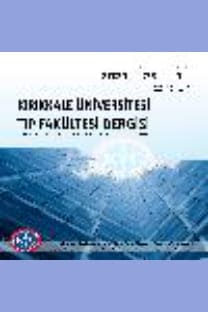İLİYAK ARTER TOTAL OKLÜZYONLARINDA ENDOVASKÜLER TEDAVİ: TEK MERKEZ DENEYİMİ
balon anjiyoplasti, endovasküler prosedürler, iliyak arter, oklüzyon, stentler, Anjiyografi, stentler
Endovascular Treatment of Iliac Artery Total Occlusions: A Single Center Experience
Angiopraphy, balloon angioplasty, endovascular procedures, iliac artery, occlusion, stents,
___
- 1. Müller AM, Langwieser N, Bradaric C, Haller B, Fusaro M, Ott Ilka et al. Endovascular treatment for steno-occlusive iliac artery disease: safety and long-term outcome. Angiology. 2018;69(4):308-15.
- 2. Neisen MJ. Endovascular management of aortoiliac occlusive disease. Semin Intervent Radiol. 2009;26(4):296-302.
- 3. Norgren L, Hiatt WR, Dormandy JA, Nehler MR, Harris KA, Fowkes FG. Inter-society consensus for the management of peripheral arterial disease (TASC II). J Vasc Surg. 2007;45:5-67.
- 4. Clair DG, Beach JM. Strategies for managing aortoiliac occlusions: access, treatment and outcomes. Expert Rev Cardiovasc Ther. 2015;13(5):551-63.
- 5. Jaff MR, Christopher JW, William RH, Gerry RF, John D, Mahmood R et al. An update on methods for revascularization and expansion of the TASC lesion classification to include below-the-knee arteries: a supplement to the inter-society consensus for the management of peripheral arterial disease (TASC II). Ann Vasc Dis. 2015;20(5):465-78.
- 6. Adili F, Balzer K, Betz T, Billing A, Böckler D, Brixner D et al. A current practice of first-line treatment strategies in patients with critical limb ischemia. J Vasc Surg. 2015; 62:965-73.
- 7. Hans SS, DeSantis D, Siddiqui R, KhouryM. Results of endovascular therapy and aortobifemoral grafting for Transatlantic Inter-Society type C and D aortoiliac occlusive disease. Surgery. 2008;144(4):583-9.
- 8. Jongkind V, Akkersdijk GJ, Yeung KK, Wisselink W. A systematic review of endovascular treatment of extensive aortoiliac occlusive disease. J Vasc Surg. 2010;52:1376-83.
- 9. Ye W, Liu CW, Ricco JB, Mani K, Zeng R, Jiang J. Early and late outcomes of percutaneous treatment of Transatlantic Inter-Society Consensus class C and D aorto-iliac lesions. J Vasc Surg. 2011;53:1728-37.
- 10. LeVille CD, Kashyap VS, Clair DG, Bena JF, Leyden SP, Greenberg RK et al. Endovascular management of iliac artery occlusion: extending treatment to transatlantic inter-society consensus class C and D patients. J Vasc Surg. 2006;43(1):32-9.
- 11. Indes JE, Mandawat A, Tuggle CT, Muhs B, Sosa JA. Endovascular pro¬cedures for aorto-iliac occlusive disease are associated with superior short-term clinical and economic outcomes com¬pared with open surgery in the inpatient population. J Vasc Surg. 2010;52:1173-9.
- 12. Indes JE, Pfaff MJ, Farrokhyar F, Brown H, Hashim P, Cheung K et al. Clinical outcomes of 5358 patients undergoing direct open bypass or endovascu¬lar treatment for aortoiliac occlusive disease: a systematic review and meta-analysis. J Endovasc Ther. 2013;20:443-55.
- 13. Clair DG, Adams J, Reen B, Feldman R, Starr J, Diaz-Cartelle J et al. The EPIC nitinol stent system in the treatment of iliac artery lesions: one-year results from the ORION clinical trial. J Endovasc Ther. 2014;21:213-22.
- 14. Mousa AY, Beauford RB, Flores L, Faries P, Patel P, Fogler R. Endovascular treatment of iliac occlusive disease: review and update. Vascular. 2007;15(1):5-11.
- 15. Gardiner GA Jr, Sullivan KL, Halpern EJ, Parker L, Beck M, Bonn J et al. Angiographic assessment of initial balloon angioplasty results. J Vasc Interv Radiol. 2004;15:1081-7.
- ISSN: 2148-9645
- Yayın Aralığı: 3
- Başlangıç: 1999
- Yayıncı: KIRIKKALE ÜNİVERSİTESİ KÜTÜPHANE VE DOKÜMANTASYON BAŞKANLIĞI
Eylem KARATAY, Kebire KARAKUŞ, Deniz ÖĞÜTMEN KOÇ, Rahime ÖZGÜR
İLİYAK ARTER TOTAL OKLÜZYONLARINDA ENDOVASKÜLER TEDAVİ: TEK MERKEZ DENEYİMİ
BÖBREK ÜSTÜ BEZLERİNİN DİFÜZYON AĞIRLIKLI GÖRÜNTÜLEME İLE NORMAL ADC DEĞER ARALIKLARININ SAPTANMASI
Mirace Yasemin KARADENİZ BİLGİLİ
İskemik Kolon Anastomoz İyileşmesinde Timokinon, Zeolit ve Plateletten Zengin Plazmanın Etkinliği
Faruk PEHLİVANLI, Gökhan KARACA, OKTAY AYDIN, Canan ALTUNKAYA, İbrahim Tayfun ŞAHİNER, Hüseyin ÖZDEN, Hafize UZUN, Mevlüt Recep PEKCİCİ
Adil DOĞAN, Veysel BURULDAY, Murat ALPUA
UZUN SPİNAL KORD LEZYONU OLAN HASTADA BİYOPSİ İLE NÖROMİYELİTİS OPTİKA TANISI: OLGU SUNUMU
Ceyda TANOĞLU, Ruhsen ÖNCEL ÖCAL, Münire KILINÇ TOPRAK
OKTAY AYDIN, Faruk PEHLİVANLI, Gökhan KARACA, Çağatay DAPHAN, KUZEY AYDINURAZ, akan BOYUNAĞA, Salim NESELİOGLU, Özcan EREL
